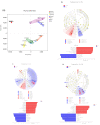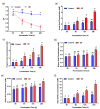Assessing the Effects of Ginger Extract on Polyphenol Profiles and the Subsequent Impact on the Fecal Microbiota by Simulating Digestion and Fermentation In Vitro
- PMID: 33086593
- PMCID: PMC7650818
- DOI: 10.3390/nu12103194
Assessing the Effects of Ginger Extract on Polyphenol Profiles and the Subsequent Impact on the Fecal Microbiota by Simulating Digestion and Fermentation In Vitro
Abstract
The beneficial effects of ginger polyphenols have been extensively reported. However, their metabolic characteristics and health effects on gut microbiota are poor understood. The purpose of this study was to investigate the digestion stability of ginger polyphenols and their prebiotic effects on gut microbiota by simulating digestion and fermentation in vitro. Following simulated digestion in vitro, 85% of the polyphenols were still detectable, and the main polyphenol constituents identified in ginger extract are 6-, 8-, and 10-gingerols and 6-shogaol in the digestive fluids. After batch fermentation, the changes in microbial populations were measured by 16S rRNA gene Illumina MiSeq sequencing. In mixed-culture fermentation with fecal inoculate, digested ginger extract (GE) significantly modulated the fecal microbiota structure and promoted the growth of some beneficial bacterial populations, such as Bifidobacterium and Enterococcus. Furthermore, incubation with GE could elevate the levels of short-chain fatty acids (SCFAs) accompanied by a decrease in the pH value. Additionally, the quantitative PCR results showed that 6-gingerol (6G), as the main polyphenol in GE, increased the abundance of Bifidobacterium significantly. Therefore, 6G is expected to be a potential prebiotic that improves human health by promoting gut health.
Keywords: 6-gingerol; ginger extract; gut microbiota; in vitro fermentation; short-chain fatty acids.
Conflict of interest statement
The authors declare no competing financial interest.
Figures




Similar articles
-
In vitro gastrointestinal digestion and fecal fermentation behaviors of pectin from feijoa (Acca sellowiana) peel and its impact on gut microbiota.Food Res Int. 2024 Dec;197(Pt 2):115301. doi: 10.1016/j.foodres.2024.115301. Epub 2024 Nov 8. Food Res Int. 2024. PMID: 39577949
-
Promotion of Mitochondrial Biogenesis via Activation of AMPK-PGC1ɑ Signaling Pathway by Ginger (Zingiber officinale Roscoe) Extract, and Its Major Active Component 6-Gingerol.J Food Sci. 2019 Aug;84(8):2101-2111. doi: 10.1111/1750-3841.14723. Epub 2019 Aug 1. J Food Sci. 2019. PMID: 31369153
-
Oat bran, but not its isolated bioactive β-glucans or polyphenols, have a bifidogenic effect in an in vitro fermentation model of the gut microbiota.Br J Nutr. 2019 Mar;121(5):549-559. doi: 10.1017/S0007114518003501. Epub 2019 Jan 28. Br J Nutr. 2019. PMID: 30688188
-
Prebiotics in vitro digestion by gut microbes, products' chemistry, and clinical relevance.Appl Microbiol Biotechnol. 2021 Jan;105(1):13-19. doi: 10.1007/s00253-020-11021-z. Epub 2020 Nov 17. Appl Microbiol Biotechnol. 2021. PMID: 33201272 Review.
-
Protective and therapeutic potential of ginger (Zingiber officinale) extract and [6]-gingerol in cancer: A comprehensive review.Phytother Res. 2018 Oct;32(10):1885-1907. doi: 10.1002/ptr.6134. Epub 2018 Jul 16. Phytother Res. 2018. PMID: 30009484 Review.
Cited by
-
Anti-Aging Effect of Dietary Fiber Compound Mediated by Guangxi Longevity Dietary Pattern on Natural Aging Mice.Nutrients. 2022 Aug 3;14(15):3181. doi: 10.3390/nu14153181. Nutrients. 2022. PMID: 35956357 Free PMC article.
-
Antioxidant Activity of Vitis davidii Foex Seed and Its Effects on Gut Microbiota during Colonic Fermentation after In Vitro Simulated Digestion.Foods. 2022 Aug 29;11(17):2615. doi: 10.3390/foods11172615. Foods. 2022. PMID: 36076800 Free PMC article.
-
Influence of Diet on the Bioavailability of Active Components from Zingiber officinale Using an In Vitro Digestion Model.Foods. 2023 Oct 24;12(21):3897. doi: 10.3390/foods12213897. Foods. 2023. PMID: 37959015 Free PMC article.
-
6-gingerol and its derivatives inhibit Helicobacter pylori-induced gastric mucosal inflammation and improve gastrin and somatostatin secretion.Front Microbiol. 2024 Aug 21;15:1451563. doi: 10.3389/fmicb.2024.1451563. eCollection 2024. Front Microbiol. 2024. PMID: 39234535 Free PMC article.
-
The influence of in vitro gastrointestinal digestion and fecal fermentation on the flowers of Juglans regia: Changes in the active compounds and bioactivities.Front Nutr. 2022 Sep 7;9:1014085. doi: 10.3389/fnut.2022.1014085. eCollection 2022. Front Nutr. 2022. PMID: 36159499 Free PMC article.
References
MeSH terms
Substances
Grants and funding
LinkOut - more resources
Full Text Sources
Medical

